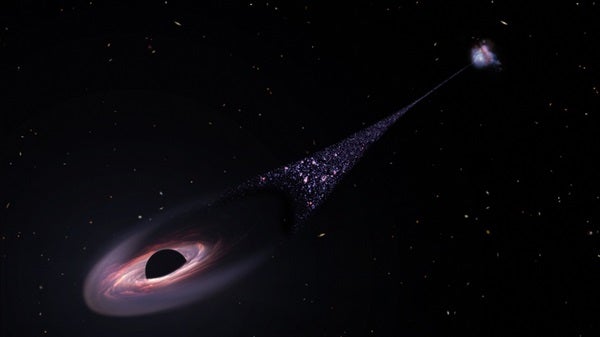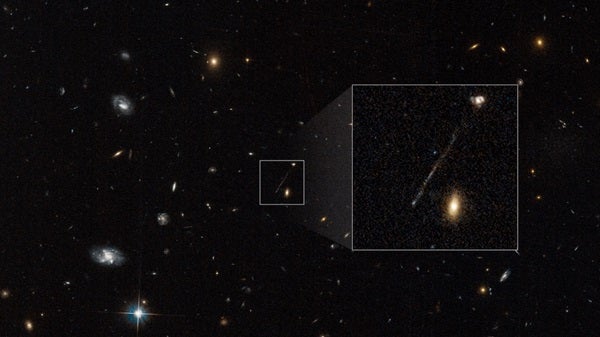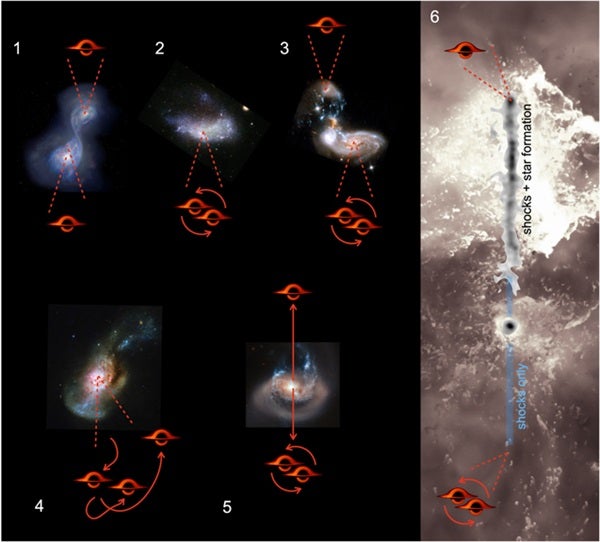
Astronomers think they’ve discovered a black hole some 20 million times the mass of the Sun speeding away from the core of a distant galaxy. And as the supermassive black hole barrels through intergalactic space, it’s compressing the scant gas and dust available out there, leaving behind a thin line of newly formed stars that’s some 200,000 light-years long.
“We think we’re seeing a wake behind the black hole where the gas cools and is able to form stars,” said Pieter van Dokkum of Yale University, who first identified the star trail, in a NASA release. “What we’re seeing is the aftermath. Like the wake behind a ship, we’re seeing the wake behind the black hole.”
Despite being relatively thin, the black hole’s stellar wake is packed with plenty of hot blue stars, making it nearly half as bright as the parent galaxy it traces back to. Based on the available evidence, the researchers think this black hole was likely ejected during a complex dance between three supermassive black holes that were involved in a pair of galaxy mergers. If confirmed, this would be the first observational evidence showing that supermassive black holes can be ejected from their parent galaxies.
A paper detailing the candidate runaway black hole and its stellar wake was published April 6 in The Astrophysical Journal Letters.
Not so invisible after all
Although black holes themselves do not emit light, they often leave behind visible traces of their existence. For instance, many black holes are surrounded by dense disks of swirling, superheated gas and dust. Such accretion disks do emit copious light, making a black hole’s presence clearly known.

But it wasn’t an accretion disk that gave away this black hole. It was the unusual linear streak seemingly linking it to a nearby galaxy, which van Dokkum first noticed in an image captured by the Hubble Space Telescope. He and his team later confirmed the streak is indeed linked to the galaxy with follow-up observations taken with the Keck Observatory in Hawaii.
“This is pure serendipity that we stumbled across it,” said van Dokkum, who was initially looking at the Hubble image to investigate an unrelated dwarf galaxy. “I was just scanning through the Hubble image and then I noticed that we have a little streak.” He says he initially almost dismissed it as an imaging artifact, but “[w]hen we eliminated cosmic rays we realized it was still there. It didn’t look like anything we’ve seen before.”
The researchers also investigated the possibility that the streak was an astrophysical jet shooting from the black hole core of the nearby galaxy — which is not an uncommon sight. But the streak gets stronger farther from the core of the galaxy, and it doesn’t fan out at the end, leading the researchers to conclude the streak is instead a trail of new stars.

At the outer tip of the streak, where the suspected black hole is thought to be, the researchers also see evidence of a shock wave in front of the black hole. “Gas in front of it gets shocked because of this supersonic, very high-velocity impact of the black hole moving through the gas,” said van Dokkum. “How it works exactly is not really known.”
The astronomers think this runaway black hole was likely ejected from its parent galaxy after two separate galaxy mergers in the semi-recent past. The first merger between two galaxies would have occurred roughly 50 million years ago, resulting in the two galaxies’ supermassive black holes entering orbit around one another.
Then, a later merger with a third galaxy threw the three supermassive black holes into a chaotic dance that ultimately led to the solitary black hole being ejected from the system altogether. The team also thinks that when the isolated black hole was thrown out, the remaining pair of binary black holes should have been thrown off in the opposite direction.
In order to confirm this hypothesis, the team next plans to capture follow-up observations with the James Webb Space Telescope and the Chandra X-ray Observatory.









